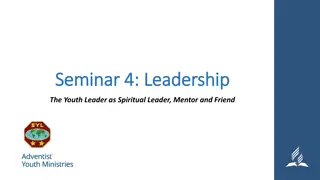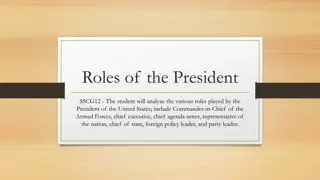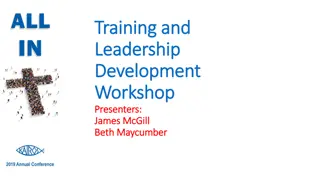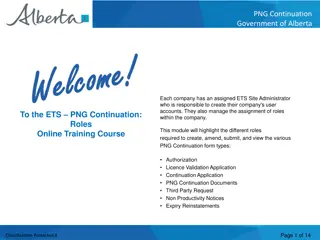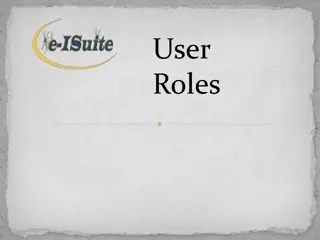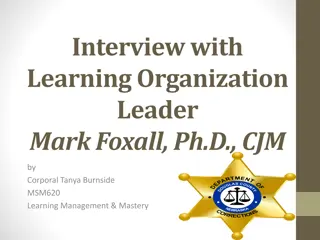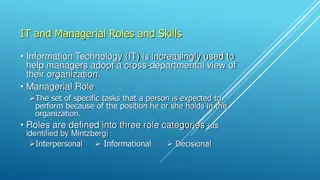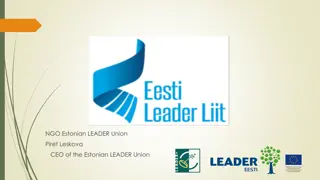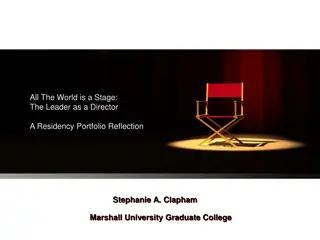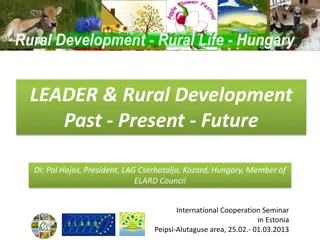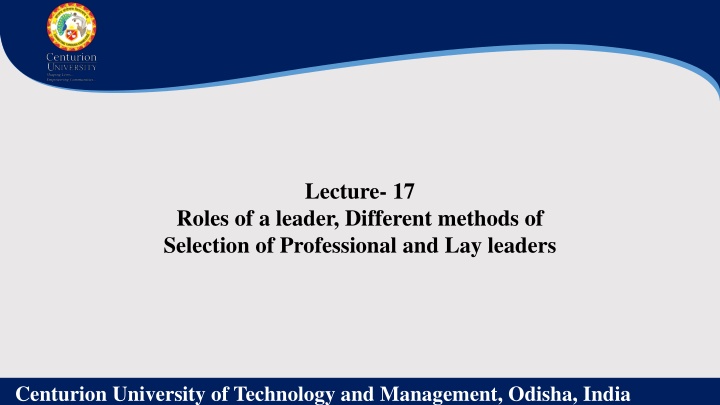
Leadership Roles and Selection Methods at Centurion University
Explore the roles of leaders and various selection methods for professional and lay leaders at Centurion University in Odisha, India. Learn about the characteristics of autocratic, democratic, and laissez-faire leaders, as well as the significant roles leaders play in groups. Gain insights into group spokesman, harmonizer, planner, executive, educator, and symbol of group ideals. Discover the essence of leadership in influencing attitudes and actions towards achieving common purposes.
Download Presentation

Please find below an Image/Link to download the presentation.
The content on the website is provided AS IS for your information and personal use only. It may not be sold, licensed, or shared on other websites without obtaining consent from the author. If you encounter any issues during the download, it is possible that the publisher has removed the file from their server.
You are allowed to download the files provided on this website for personal or commercial use, subject to the condition that they are used lawfully. All files are the property of their respective owners.
The content on the website is provided AS IS for your information and personal use only. It may not be sold, licensed, or shared on other websites without obtaining consent from the author.
E N D
Presentation Transcript
Lecture- 17 Roles of a leader, Different methods of Selection of Professional and Lay leaders Centurion University of Technology and Management, Odisha, India
LEADERSHIP According to Niderfrank (1966) leadership is essential in simply influencing attitudes and actions of one or more persons leading towards the achievement or so purpose. Centurion University of Technology and Management, Odisha, India
Characteristics of Leaders: The characteristics of leaders differ. The characteristics of three types of leaders are as detailed: 1) Autocratic- a) Determines all policies, activities and goals of the organization. b) Takes no part in work except when conducting meeting, telling others what to do or demonstrating. c) Members are uncertain about what to do and usually take actions they are told to take. d) Leader is personal in both praise and criticism of the work. Centurion University of Technology and Management, Odisha, India
2) Democratic- a) Produces a shared leadership that permits a feeling of satisfaction and achievement. b) Helps the members of understand the steps required in working. c) Members take more responsibility for group maintenance and task performance. 3) Laissezfaire- a) Gives minimum guidance b) Remains in the background and seldom express an opinion or works with a minimum of roles. c) Members often act as leaders in making decisions that guide the organization. Centurion University of Technology and Management, Odisha, India
Role of Leaders Reddy (1987) brought out the following eight important roles. 1. Group Spokesman- Leader has the responsibility to speak for the group and representing the group's interests and position faithfully and accurately. 2. Group Harmonizer- All groups will usually have both uniformities and differences of opinion. The leader is responsible for pointing out to the group when potential conflict situations arise, that the common purpose is sufficiently worthy of co-operation that the differences be resolved peacefully. 3. Group Planner- Generally persons are chosen for leadership positions because it is assumed that they know a little more about the problems confronting the group and their possible solutions than do the other members of the group. The group expects its leader to have new ideas for initiating activities. 4. Group Executive- Most groups have established some methods of conducting business and achieving consensus of opinion on issues that come up before them. Centurion University of Technology and Management, Odisha, India
5. Group Educator or Teacher- Leader must share with the followers' his knowledge and experience. Such sharing of experience and insight is teaching. Good leadership depends a large part upon because the good teacher is not a dictator. 6. Symbol of Group Ideals All social groups have implicit or explicit norms or ideas. As a rule, persons accepted as leaders are those who have accepted these norms and live by them. The group expects his leadership to embody the ideals of group. 7. Group Discussion Chairman This role is more related to that of group executive. In recent years there has been an increased interest in group discussions. Generally a group meets for a panel discussion or a forum or a group thinking conference as something apart from the routine business of the organization. 8. Group Supervisor The leader has to work with followers and also with group organizations like youth clubs, co- operatives, farmer's associations, etc. Therefore this role becomes important for the leader. Centurion University of Technology and Management, Odisha, India
Selection of leaders Various methods have been used by different researchers for identification of leaders. Some of the common methods of locating leaders are discussed here. 1. Sociometry: All the members of a community, group or organization are asked to name three persons in order of preference as their leaders from the same group. The name obtaining the maximum choice is accepted as the possible leader. In this method, every member of the group has to mention his choice. Assumption is that, a person liked by majority of the people is the most popular in the group and is capable of leading the group. 2. Active participants: In any group activity, the persons taking more active part can be spotted out. These are the persons who are taking initiative to make or lead in making the decisions relative to the events or actions selected. Active participants can also be located in the community meetings. Active participation is an indication of their leadership ability. Centurion University of Technology and Management, Odisha, India
3. Social Participation: Higher the social participation of a person the more is the promise in him of becoming a leader. It is assumed that a person already having active participation in the existing organizations will be useful to provide leadership in the new situation. In this method, the selection is made of those people who are already in positions in other organisations. 4. Informal meetings: In this method, the opinion of the group members selected at random is obtained through informal meetings. They are asked to name those persons to whom people go to seek for ideas or help in emergencies. Persons having respect of the neighbourhood or groups can be nominated as leaders. 5. Formal leaders: Formal leaders are those persons who hold offices in formal organizations. They are very easy to locate. One has to pick persons who are in formal organizations and public official positions. Any how, it is essential to win the confidence of these leaders; otherwise they can create many obstacles for the successful implementation of the new programme Centurion University of Technology and Management, Odisha, India
6. Persons with Reputation: These are certain persons who have the reputation for actual or potential leaders for a particular job. Even the persons having reputation being honest, intelligent and helping-hand can be selected to act as leaders because people have faith in the integrity of these people. This method is similar to the history method. 7. Self - rating Technique: In self rating technique each respondent is asked to evaluate his own abilities to act as a leader. How far others think him as influential? The success of this method depends upon frankness and boldness of a person to express his feelings. 8. Information Ratings: In this method, three or four judges are appointed to nominate the persons suitable to act as leaders for a particular activity. The names obtained in this way are sorted out by frequency mentioned, and those of high frequency are accepted as possible selectees. Only those persons with good reputation, (e.g) school teachers, officials religious persons, in a village be asked to act as judges. Centurion University of Technology and Management, Odisha, India
9. Election: The members of the group elect the leaders through vote. 10. Discussion Method: A discussion is arranged to find own one's proficiency on a subject matter. Individual's ability is assessed and recognised. On any subjects the person has sound knowledge a discussion is arranged and an individual's ability is soon recognised. Discussion gives encouragement and assurance to the potential leader to express himself, and over a period of time may make him more confident in ac some position of leadership and emerge as a value leader. 11. The Workshop Method: Through this method, where the large group breaks smaller groups and the responsibility of the programme and decision-making rests upon the smaller unit, leadership emerges in each group. Over a period of time, the extension worker can spot certain leaders who come to the front in taking responsibilities. The Extension worker or professional leader in the workshop has the position of an observer, discussion group leader, etc. Centurion University of Technology and Management, Odisha, India
12. The Group Observer: The extension worker should watch a community or group in action and then he will be able to spot potential leaders. He may observe the community in any type of situation. For obtaining the best results, the group should not be aware of this. 13. Seniority and Past Experiences: In some communities the oldest person is supposed to have the most knowledge and experiences and normally can able to stabilize the group. But this may not be a proper way of locating leader. Centurion University of Technology and Management, Odisha, India

